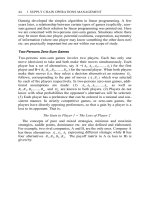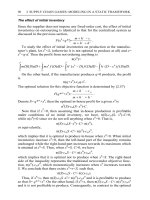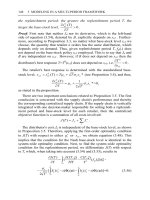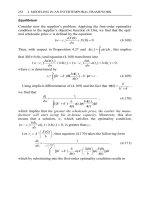Operations management heizer 6e ch04
Bạn đang xem bản rút gọn của tài liệu. Xem và tải ngay bản đầy đủ của tài liệu tại đây (675.73 KB, 110 trang )
Operations
Management
Chapter 4 Forecasting
PowerPoint presentation to accompany
Heizer/Render
Principles of Operations Management, 6e
Operations Management, 8e
© 2006
Prentice
Hall, Inc. Hall, Inc.
©
2006
Prentice
4–1
Outline
Global Company Profile:
Tupperware Corporation
What Is Forecasting?
Forecasting Time Horizons
The Influence of Product Life Cycle
Types Of Forecasts
© 2006 Prentice Hall, Inc.
4–2
Outline – Continued
The Strategic Importance Of
Forecasting
Human Resources
Capacity
Supply-Chain Management
Seven Steps In The Forecasting
System
© 2006 Prentice Hall, Inc.
4–3
Outline – Continued
Forecasting Approaches
Overview of Qualitative Methods
Overview of Quantitative Methods
© 2006 Prentice Hall, Inc.
4–4
Outline – Continued
Time-series Forecasting
Decomposition of a Time Series
Naïve Approach
Moving Averages
Exponential Smoothing
Exponential Smoothing with Trend
Adjustment
Trend Projections
Seasonal Variations in Data
Cyclical Variations in Data
© 2006 Prentice Hall, Inc.
4–5
Outline – Continued
Associative Forecasting Methods:
Regression And Correlation
Analysis
Using Regression Analysis to
Forecast
Standard Error of the Estimate
Correlation Coefficients for
Regression Lines
Multiple-Regression Analysis
© 2006 Prentice Hall, Inc.
4–6
Outline – Continued
Monitoring And Controlling
Forecasts
Adaptive Smoothing
Focus Forecasting
Forecasting In The Service Sector
© 2006 Prentice Hall, Inc.
4–7
Learning Objectives
When you complete this chapter, you
should be able to :
Identify or Define:
Forecasting
Types of forecasts
Time horizons
Approaches to forecasts
© 2006 Prentice Hall, Inc.
4–8
Learning Objectives
When you complete this chapter, you
should be able to :
Describe or Explain:
Moving averages
Exponential smoothing
Trend projections
Regression and correlation analysis
Measures of forecast accuracy
© 2006 Prentice Hall, Inc.
4–9
Forecasting at Tupperware
Each of 50 profit centers around the
world is responsible for
computerized monthly, quarterly,
and 12-month sales projections
These projections are aggregated by
region, then globally, at
Tupperware’s World Headquarters
Tupperware uses all techniques
discussed in text
© 2006 Prentice Hall, Inc.
4 – 10
Tupperware’s
Process
© 2006 Prentice Hall, Inc.
4 – 11
Three Key Factors for
Tupperware
The number of registered
“consultants” or sales
representatives
The percentage of currently “active”
dealers (this number changes each
week and month)
Sales per active dealer, on a weekly
basis
© 2006 Prentice Hall, Inc.
4 – 12
Forecast by Consensus
Although inputs come from sales,
marketing, finance, and production,
final forecasts are the consensus of
all participating managers
The final step is Tupperware’s
version of the “jury of executive
opinion”
© 2006 Prentice Hall, Inc.
4 – 13
What is Forecasting?
Process of
predicting a future
event
Underlying basis of
all business
decisions
??
Production
Inventory
Personnel
Facilities
© 2006 Prentice Hall, Inc.
4 – 14
Forecasting Time Horizons
Short-range forecast
Up to 1 year, generally less than 3 months
Purchasing, job scheduling, workforce levels,
job assignments, production levels
Medium-range forecast
3 months to 3 years
Sales and production planning, budgeting
Long-range forecast
3+ years
New product planning, facility location,
research and development
© 2006 Prentice Hall, Inc.
4 – 15
Distinguishing Differences
Medium/long range forecasts deal with
more comprehensive issues and support
management decisions regarding
planning and products, plants and
processes
Short-term forecasting usually employs
different methodologies than longer-term
forecasting
Short-term forecasts tend to be more
accurate than longer-term forecasts
© 2006 Prentice Hall, Inc.
4 – 16
Influence of Product Life
Cycle
Introduction – Growth – Maturity – Decline
Introduction and growth require longer
forecasts than maturity and decline
As product passes through life cycle,
forecasts are useful in projecting
Staffing levels
Inventory levels
Factory capacity
© 2006 Prentice Hall, Inc.
4 – 17
Product Life Cycle
Company Strategy/Issues
Introduction
Growth
Maturity
Best period to
increase market
share
Practical to change
price or quality
image
Poor time to
change image,
price, or quality
R&D engineering is
critical
Strengthen niche
Competitive costs
become critical
Defend market
position
CD-ROM
Internet
Sales
Decline
Cost control
critical
Fax machines
Drive-through
restaurants
Color printers
Flat-screen
monitors
DVD
3 1/2”
Floppy
disks
Figure 2.5
© 2006 Prentice Hall, Inc.
4 – 18
OM Strategy/Issues
Product Life Cycle
Introduction
Growth
Maturity
Decline
Product design
and
development
critical
Frequent
product and
process design
changes
Short production
runs
High production
costs
Limited models
Forecasting
critical
Product and
process
reliability
Competitive
product
improvements
and options
Increase capacity
Standardization
Less rapid
product changes
– more minor
changes
Optimum
capacity
Increasing
stability of
process
Long production
runs
Product
improvement and
cost cutting
Little product
differentiation
Cost
minimization
Overcapacity
in the
industry
Prune line to
eliminate
items not
returning
good margin
Reduce
capacity
Attention to
quality
Shift toward
product focus
Enhance
distribution
Figure 2.5
© 2006 Prentice Hall, Inc.
4 – 19
Types of Forecasts
Economic forecasts
Address business cycle – inflation rate,
money supply, housing starts, etc.
Technological forecasts
Predict rate of technological progress
Impacts development of new products
Demand forecasts
Predict sales of existing product
© 2006 Prentice Hall, Inc.
4 – 20
Strategic Importance of
Forecasting
Human Resources – Hiring, training,
laying off workers
Capacity – Capacity shortages can
result in undependable delivery, loss
of customers, loss of market share
Supply-Chain Management – Good
supplier relations and price advance
© 2006 Prentice Hall, Inc.
4 – 21
Seven Steps in Forecasting
Determine the use of the forecast
Select the items to be forecasted
Determine the time horizon of the
forecast
Select the forecasting model(s)
Gather the data
Make the forecast
Validate and implement results
© 2006 Prentice Hall, Inc.
4 – 22
The Realities!
Forecasts are seldom perfect
Most techniques assume an
underlying stability in the system
Product family and aggregated
forecasts are more accurate than
individual product forecasts
© 2006 Prentice Hall, Inc.
4 – 23
Forecasting Approaches
Qualitative Methods
Used when situation is vague
and little data exist
New products
New technology
Involves intuition, experience
e.g., forecasting sales on Internet
© 2006 Prentice Hall, Inc.
4 – 24
Forecasting Approaches
Quantitative Methods
Used when situation is ‘stable’ and
historical data exist
Existing products
Current technology
Involves mathematical techniques
e.g., forecasting sales of color
televisions
© 2006 Prentice Hall, Inc.
4 – 25









